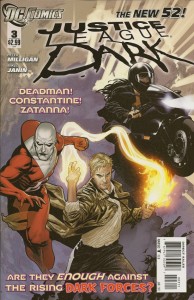 EDITOR’S NOTE: On initial publication of this review, I missed Ryan Sook’s cover credit and attributed the cover work to interior artist Mikel Janin. Mikel was good enough to check into the comments and point out my error. The review has been updated with more accurate credits.
EDITOR’S NOTE: On initial publication of this review, I missed Ryan Sook’s cover credit and attributed the cover work to interior artist Mikel Janin. Mikel was good enough to check into the comments and point out my error. The review has been updated with more accurate credits.
I am probably not the best person to objectively review this book, for a few reasons, even though I studied journalism in college. But I figure once you’ve publshed a review that contains the sentence, “This ending is so Goddamned shameful I can barely even find the fucking words,” I can pretty much chuck any pretense of journalistic objectivity out the window, at least when it comes to the Comic Book Reviews category.
With that said, let’s talk about Justice League Dark #3: I liked this book… and I shouldn’t have, by every standard I’ve set for comics in every review I have written to date.
It’s decompressed. It contains almost no action. It barely explains what happened before, assumes the reader has knowledge of comics that were canceled fifteen years ago and were long out of print, and has a cover that writes checks the comic itself doesn’t cash. I mean, at no time in this book does Zatanna ride a Batcycle, and if you’re gonna bait and switch me like that, the least artist Mikel Janin Ryan Sook could have done was put her in her fishnets for a little free-of-charge fanboy boner (Fanboy-ner? Hey, no Google results! Fanboy-ner! Trademark /copyright 2011 Crisis On Infinite Midlives!). And John Constantine does not shoot fire from his hands, Mikel Ryan. The only way his hand should look like that would immediately after fingerblasting Veneria, the Harpy Queen of Tertiary Chlamydia.
So I shouldn’t like this book. But it has four things going for it: Shade, The, Changing and Man.
Back when I was studying journalism in college, and being taught not to use words in articles like “douchenozzle”, “yambaggers” and “fanboy-ner”, I had a limited budget for comics, thanks to my astronomical budgets for whiskey and cigarettes. So I had to be very selective with the comics I bought… and what I selected were Vertigo comics. Well, they weren’t Vertigo Comics at the time, they were just DC Comics, but they were the same books they were when they fell under the Vertigo imprint in 1993. The difference was that they were all out on the edge of the DC Universe. Sometimes you would see the DC heroes in the books, and vice versa – John Constantine was on the Justice League satellite during Crisis on Infinite Earths, for Christ’s sake.
Pretty much all those crossovers went away when the books went Vertigo, but I have fond memories of those comics at that time… and Justice League Dark is trying like hell to recapture the feel of those books.
Don’t get me wrong, this books has problems. Like I said, we see Shade conjure a character that has a big impact on me, because I read all those Shade books in the 90’s, but who means fuckall to the “new readers” that the New 52 was supposed to bring into comic stores. And this story is building so slowly that we’re three months and nine dollars in, and we still haven’t seen more than two of the primary characters in the same place at the same time… which is a strange choice for a team book named Justice League Dark.
However, when it comes to the art, this book is firing along pretty well. While I question Janin’s Sook’s choices on the bait and switch cover, the Janin’s internal art is solid. A horror book like this requires the ability to switch between the mundane and the fantastic, which Janin does admirably. His facial expressions are solid, and his art isn’t overly stylized, which is a trap that books like this make artists fall into almost continually (Hello, entire art staff of Eternity Comics!). And, for an old Shade fan, he captures the effects of Shade’s Madness Vest, as established by original Shade artist Chris Bachalo, without going overboard. It’s pretty, and it works.
I can’t recommend this book to almost anyone. It requires a commitment to slow storytelling, a willingness to stick through long stretches with almost no action (But the action that’s here? Where Deadman intervenes with a suicide jumper on her way down? Sweet.), and an understanding of twenty years of comics in order to fully appreciate.
But if you’re anything like me, and you remember those early proto-Vertigo books from the early 1990’s where the horror genre could interact with the superhero genre? This book is in your wheelhouse. It totally captures the feeling of those comics, and your should be buying it. You, and your fanboy-ner, will thank me.
 Podcast RSS Feed
Podcast RSS Feed iTunes
iTunes Google Play
Google Play Stitcher
Stitcher TuneIn Radio
TuneIn Radio Android
Android Miro Media Player
Miro Media Player Comics Podcast Network
Comics Podcast Network